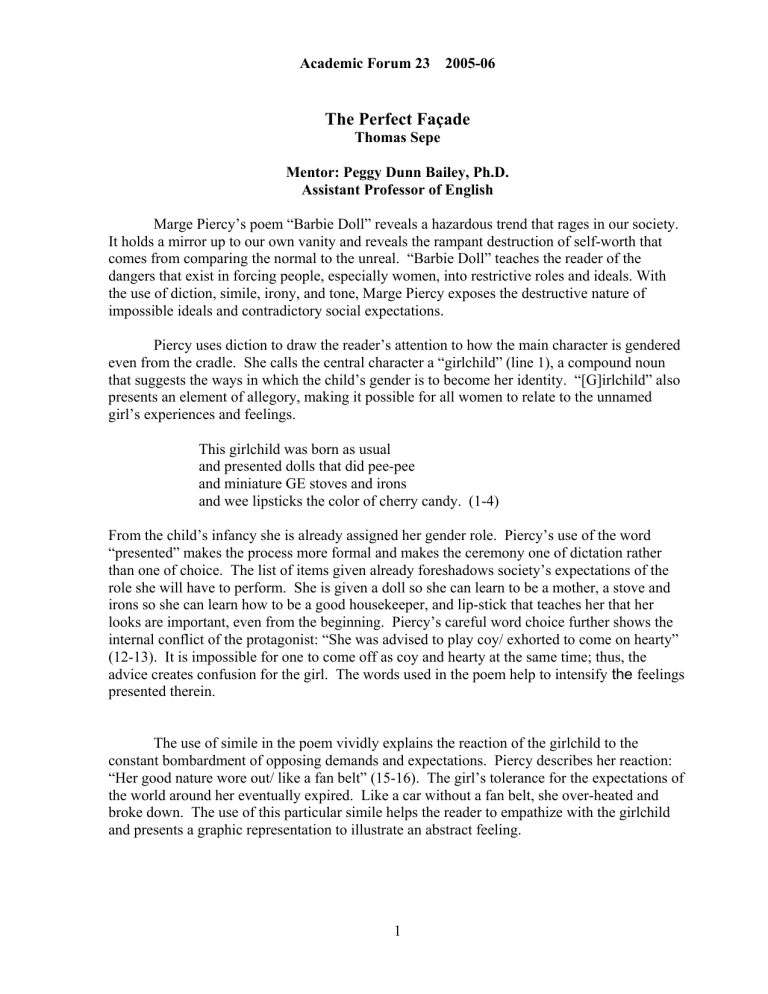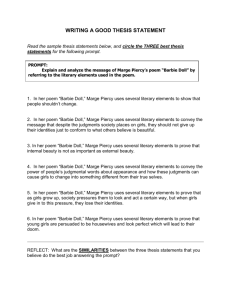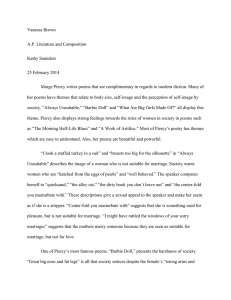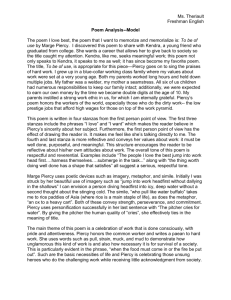
Academic Forum 23 2005-06 The Perfect Façade Thomas Sepe Mentor: Peggy Dunn Bailey, Ph.D. Assistant Professor of English Marge Piercy’s poem “Barbie Doll” reveals a hazardous trend that rages in our society. It holds a mirror up to our own vanity and reveals the rampant destruction of self-worth that comes from comparing the normal to the unreal. “Barbie Doll” teaches the reader of the dangers that exist in forcing people, especially women, into restrictive roles and ideals. With the use of diction, simile, irony, and tone, Marge Piercy exposes the destructive nature of impossible ideals and contradictory social expectations. Piercy uses diction to draw the reader’s attention to how the main character is gendered even from the cradle. She calls the central character a “girlchild” (line 1), a compound noun that suggests the ways in which the child’s gender is to become her identity. “[G]irlchild” also presents an element of allegory, making it possible for all women to relate to the unnamed girl’s experiences and feelings. This girlchild was born as usual and presented dolls that did pee-pee and miniature GE stoves and irons and wee lipsticks the color of cherry candy. (1-4) From the child’s infancy she is already assigned her gender role. Piercy’s use of the word “presented” makes the process more formal and makes the ceremony one of dictation rather than one of choice. The list of items given already foreshadows society’s expectations of the role she will have to perform. She is given a doll so she can learn to be a mother, a stove and irons so she can learn how to be a good housekeeper, and lip-stick that teaches her that her looks are important, even from the beginning. Piercy’s careful word choice further shows the internal conflict of the protagonist: “She was advised to play coy/ exhorted to come on hearty” (12-13). It is impossible for one to come off as coy and hearty at the same time; thus, the advice creates confusion for the girl. The words used in the poem help to intensify the feelings presented therein. The use of simile in the poem vividly explains the reaction of the girlchild to the constant bombardment of opposing demands and expectations. Piercy describes her reaction: “Her good nature wore out/ like a fan belt” (15-16). The girl’s tolerance for the expectations of the world around her eventually expired. Like a car without a fan belt, she over-heated and broke down. The use of this particular simile helps the reader to empathize with the girlchild and presents a graphic representation to illustrate an abstract feeling. 1 Academic Forum 23 2005-06 “Barbie Doll” has a degree of irony that emphasizes the girlchild’s situation, especially in her relation to others. Once during the “magic of puberty, a classmate said:/You have a great big nose and fat legs”(5-6); in time she comes to believe that “[e]veryone saw a fat nose on thick legs” (11). This angst that she feels eventually comes to a head, and she commits suicide by “cut[ting] off her nose and legs/ and offer[ing] them up” (17-18). It is ironic that only at this time, as she is “displayed on silk” (19), does she gain approval. Doesn’t she look pretty? Everyone said. Consummation at last. To every woman a happy ending. (23-25) It is ironic that only with “the undertaker’s cosmetics” (20) and a “turned up putty nose” (21) is she referred to as being pretty. The irony of the last two lines, that she achieved completion and happiness only through something sad, suicide, solidifies the poem’s theme of the effects of trying to be the impossible. Piercy blends diction, simile, and irony to create a unique tone of lightness that contrasts the reality of the main character, a contrast which is itself a mirror of the girl’s life. The author says that one of the milestones of the girl’s life happens in the “magic of puberty” (5). Puberty is a time of awkward transitions and not a time of magic, but expressing it in such a nonchalant way gives a contradiction similar to the emotions the girlchild feels in this time of her life. The author tells of her qualities, calling her “healthy,” “intelligent,” (7) and strong but does not let the reader forget her “fat nose” and “thick legs” (11). The tone that the author creates makes the poem into a portrait of the girlchild with its contradictions and irony. Even with the constant movements forward in equality and understanding, we still live in a world divided by the roles handed to us. We live in a world where women meet resistance in the pursuit of a career in business, and a man is frowned upon for being a nurse, and where our youth are surrounded by conflicting ideals and expectations. It is necessary to have a reminder, such as the poem “Barbie Doll,” that we cannot force one another into a standardized mold. Piercy describes the purpose of her poem as giving “…voice to something in the experience of a life …. To find ourselves spoken for in art gives dignity to our pain, our anger, our lust, our losses. We can hear what we hope for and what we most fear in the small release of cadenced utterance” (“Sidelights,” par. 2). The relevance of “Barbie Doll” is as potent as when it was published in 1969. Even though some of the battlefields of understanding have changed, the reason for the war has not. Piercy’s poem, “Barbie Doll,” through its diction, simile, irony, and tone, exhorts its readers to reevaluate the influences in their lives and the influence they are in the lives of others. Through her poem Piercy shows us the destructive nature of our own society. “This girlchild was born as usual” but was not allowed to focus on her health, intelligence, and strength; she was left with nothing but the satisfaction that she is now a cookie-cutter corpse. May we all remove our masks, tear down our façades, and accept our neighbors as we would like to be accepted. 2 Academic Forum 23 2005-06 Works Cited Piercy, Marge. “Barbie Doll.” An Introduction to Literature. Ed. Sylvan Barnet, William Burto, and William E. Cain. 13th ed. New York: Pearson Longman, 2004. 700-701. “Sidelights.” “Marge Piercy”. Contemporary Authors Online. Thompson Gale. 2004. 10 November 2005. http://galenet.galegroup.com/servlet/GLD/ Biography Thomas Sepe is a freshman at Henderson State University. He is studying Political Science as a major and pursuing a minor in English. Sepe spent two years in Brazil doing missionary work before coming to Henderson. He currently resides in Cabot, Arkansas. 3


